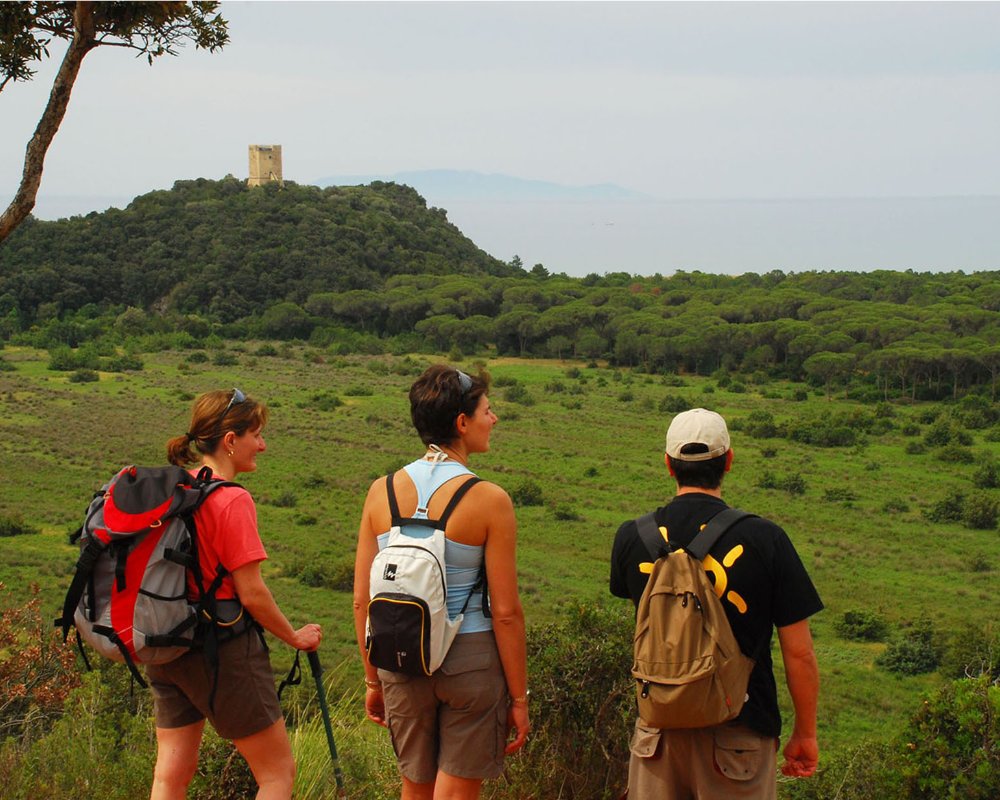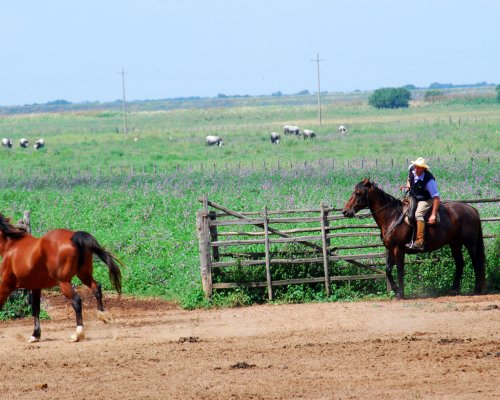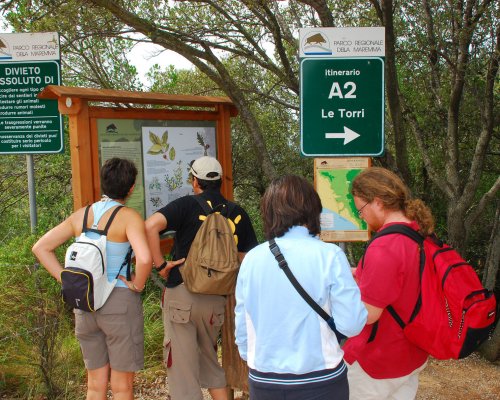Cowboys, cattle, and open spaces
This is the Tuscany of cowboys and herds of wild cattle. Here in the Maremma, the uncertain destiny of the cows of the Maremma, with their lyre-shaped horns, is linked to that of the cowboy, a legendary figure that risks vanishing forever in the face of modern, profit-focused animal husbandry. This fascinating profession has gotten a bit easier these days than in the past, but it’s kept alive by very few companies in the province of Grosseto. However, in the world’s collective imagination, these cowboys are still the icons of a Maremma surrounded by marshes, pine forests, cultivated fields and pastures. We’ll take you on a journey of discovery in one of the best-preserved and most beautiful countrysides in Italy, along the Tyrrhenian coast from the Principina a Mare up to the Talamone Gulf.
The Nature Park of the Maremma shows you a rare group of ecosystems where humans have been present for many years without damaging the delicate balance between the water, the land and the vegetation that are deeply rooted in the areas of the Trappola Marshes and the mouth of the Ombrone river. Marina di Alberese’s historic pine forest hosts an incredible number of wild animals and interesting plants. The hills of the Monti dell’Uccellina that stretch along the coast are designated as Sites of Community Importance(pSIC) and Special Protection Areas (SPA) for their beautiful landscapes and environmental and historical value.
There’s also a well-curated network of hiking trails in this protected area. You need to buy an entry ticket at the Alberese Visitor Center. The ticket price includes a shuttlebus that accompanies hikers to the meet-up point in the park (in the town of Pinottolai), where many of the park’s paths begin.
Starting from the Alberese Visitor Center, after buying the entry ticket for the Nature Park of the Maremma, you can follow via del Bersagliere until you reach the parish of Alberese, built in 1937 in a modern Romanesque style. Here you can start the A1 Tour that takes you through the woods and goes up to the Benedictine Monastery of S. Rabano. The medieval ruins of this abbey complex, which are undergoing a conservative restoration, are located in a depression, quietly nestled among tall oak trees between Poggio Uccellina and Poggio Lecci. This 11th-century religious center, created in a Lombard Romanesque style by the Cassinesi Benedictine monks, was transformed into a fortress and then abandoned in 1331 after the last line of Cistercian monks and Jerusalemite knights of San Giovanni Battista del Priorato di Pisa passed away. This is the beautiful spot where the Torre dell’Uccellina stands. This tower was built in 1321 and raised in the 16th century. Along with other Saracen watchtowers along the coast, the Torre dell’Uccellina warned the population when Turkish pirates landed. This watchtower is about 22 meters tall and has four floors. From here, you can view the Tuscan Archipelago and the Monti dell’Uccellina.
Starting from the Alberese Visitor Center, after buying the entry ticket for the Nature Park of the Maremma, you can follow via del Bersagliere until you reach the parish of Alberese, built in 1937 in a modern Romanesque style. Here you can start the A1 Tour that takes you through the woods and goes up to the Benedictine Monastery of S. Rabano. The medieval ruins of this abbey complex, which are undergoing a conservative restoration, are located in a depression, quietly nestled among tall oak trees between Poggio Uccellina and Poggio Lecci. This 11th-century religious center, created in a Lombard Romanesque style by the Cassinesi Benedictine monks, was transformed into a fortress and then abandoned in 1331 after the last line of Cistercian monks and Jerusalemite knights of San Giovanni Battista del Priorato di Pisa passed away. This is the beautiful spot where the Torre dell’Uccellina stands. This tower was built in 1321 and raised in the 16th century. Along with other Saracen watchtowers along the coast, the Torre dell’Uccellina warned the population when Turkish pirates landed. This watchtower is about 22 meters tall and has four floors. From here, you can view the Tuscan Archipelago and the Monti dell’Uccellina.
From the ruins of the complex of the Church of S. Maria Alborense, you can head down along the A1 Tour path towards the Collelungo olive grove. You can then cross the plain following the A2 Tour that shows you where to find the Collelungo promontory and the 16th-century Tower of the same name. There’s nothing left of the Saracens, but their watchtowers offer exceptionally beautiful views over the sea and the islands of the Tuscan Archipelago.
From the ruins of the complex of the Church of S. Maria Alborense, you can head down along the A1 Tour path towards the Collelungo olive grove. You can then cross the plain following the A2 Tour that shows you where to find the Collelungo promontory and the 16th-century Tower of the same name. There’s nothing left of the Saracens, but their watchtowers offer exceptionally beautiful views over the sea and the islands of the Tuscan Archipelago.
Continuing on the A2 Tour, you will head closer to sea level. The vegetation around the sand dunes shows you just how close the sea is. Along this path you’ll find deer and even wolves in the Mediterranean scrub and along the sandy shore. Wise hikers will remember to pack bathing suits and towels to enjoy this well-deserved break. From the sandy shore, fit travelers can climb to the Torre di Castel Marino, continuing along the A2 Tour. This 12th-century watchtower offers you a beautiful panorama of the sea and the vast, thriving coastal pine grove. After reclamation works in the 1700s, this pine grove replaced the swamps that extended from the mouth of the Ombrone river to the Monti dell’Uccellina.
Continuing on the A2 Tour, you will head closer to sea level. The vegetation around the sand dunes shows you just how close the sea is. Along this path you’ll find deer and even wolves in the Mediterranean scrub and along the sandy shore. Wise hikers will remember to pack bathing suits and towels to enjoy this well-deserved break. From the sandy shore, fit travelers can climb to the Torre di Castel Marino, continuing along the A2 Tour. This 12th-century watchtower offers you a beautiful panorama of the sea and the vast, thriving coastal pine grove. After reclamation works in the 1700s, this pine grove replaced the swamps that extended from the mouth of the Ombrone river to the Monti dell’Uccellina.
From the beach, you can start along the A3 Tour that follows an old drainage canal up to Ponte Tartarughe, the pivot point where different paths of the Nature Park of the Maremma branch off. Walking along, immersed in the beautiful and peaceful countryside of the Pineta Granducale, our tour will direct you to Pinottolai. Walk for 16,000 meters in the shade of local pine trees that were planted in the 1700s by the Grand Dukes of the Lorena dynasty after the canalization of the marshy area, which previously fostered malaria. Along this route, if you’re lucky, you might see some deer, boars and roe deer. Wild rabbits, hares, wolves, porcupines, badgers, martens, stone martens, skunks and weasels also live in this protected area. When there’s good weather, the Park Authority’s shuttlebus can take hikers back to the Albarese Visitor Center. The service is suspended from November 1st through mid-March. In this period, we would suggest bringing a car to Pinottolai.
For information about logistics, ticket purchases and the shuttlebus from the Park’s Visitor Centers, please refer to the website.
From the beach, you can start along the A3 Tour that follows an old drainage canal up to Ponte Tartarughe, the pivot point where different paths of the Nature Park of the Maremma branch off. Walking along, immersed in the beautiful and peaceful countryside of the Pineta Granducale, our tour will direct you to Pinottolai. Walk for 16,000 meters in the shade of local pine trees that were planted in the 1700s by the Grand Dukes of the Lorena dynasty after the canalization of the marshy area, which previously fostered malaria. Along this route, if you’re lucky, you might see some deer, boars and roe deer. Wild rabbits, hares, wolves, porcupines, badgers, martens, stone martens, skunks and weasels also live in this protected area. When there’s good weather, the Park Authority’s shuttlebus can take hikers back to the Albarese Visitor Center. The service is suspended from November 1st through mid-March. In this period, we would suggest bringing a car to Pinottolai.
For information about logistics, ticket purchases and the shuttlebus from the Park’s Visitor Centers, please refer to the website.


